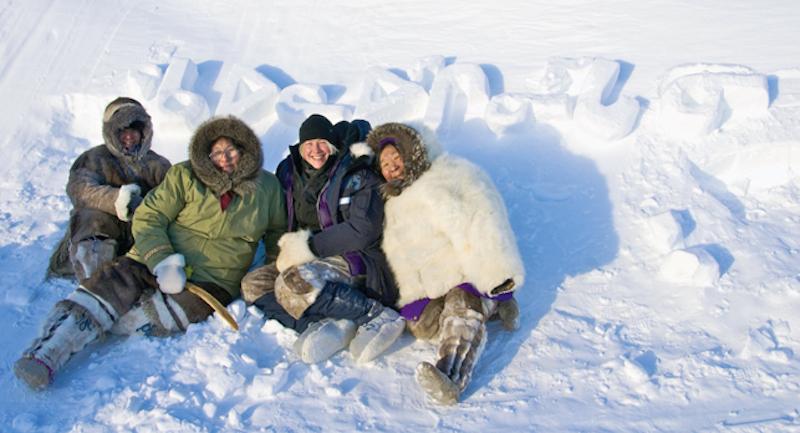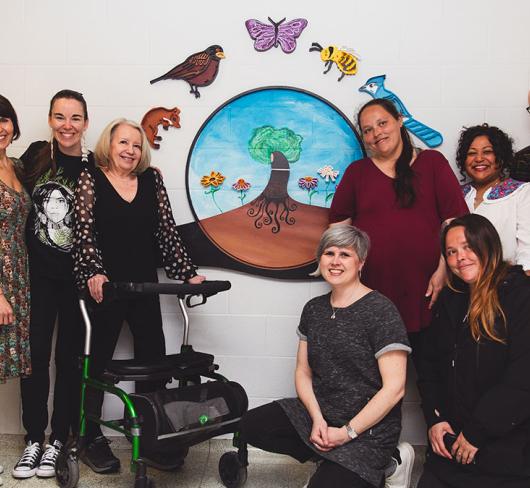
Aboriginal Women Practicing Leadership
I work in an academic institution and a few years ago I was being considered for tenure. As part of my process I was required to attend a meeting of my faculty’s Tenure and Promotions Committee and present my case. Reflecting on my first five years working as teacher/researcher in the university, I was supposed to build a case that would prove to the committee that the work I had accomplished met the university’s standard for tenure and promotion. Participating in this Euro-informed practice caused me to think about the work of Aboriginal women who were my mentors and guides. Rather than assess my accomplishments against the demands of the university, I asked myself: “Does my work contribute to and is it informed by the ways in which Aboriginal women practise leadership in our communities?”
My understanding of leadership as practised by Aboriginal women is derived from my experiences working with, reading, listening to, and sometimes observing from a distance the work of Aboriginal women. Aboriginal leadership is informed by what I refer to as the “Four Rs of Aboriginal Education”: remembering, relationship, responsibility and reciprocity. These concepts cannot be separated; they intertwine and inform each other.
As Aboriginal women, remembering who we are, and honouring our ways of knowing and being, is difficult and purposeful work crucial to our survival. We work in relationship with each other, recovering our languages and our ways of knowing. We take our responsibilities to past and future generations seriously. We work cognizant of the concept of reciprocity, never taking without giving back. In this article, I share the stories of women I look to as mentors and guides, women who practise and contribute to my understanding of Aboriginal leadership.
JO-ANNE ARCHIBALD:
Remembering and leadership
In her book Indigenous Storywork, teacher-educator Jo-ann Archibald of the Sto:lo Nation writes about her learning journey, which began with a dream.
“I needed to learn how to hear what the Elders had told me in the dream. After learning how to listen to the stories, I was expected to use their cultural knowledge and to share it with others, thereby ensuring its continuation. Important knowledge and wisdom contain power, if one comes to understand and appreciate the power of a particular knowledge, then one must be ready to share and teach it respectfully and responsibly to others in order for this knowledge, and its power to continue.”2
Archibald explains that her cultural values, beliefs, lessons, and understandings are formed through learning relationships with Elders. Recognizing that Indigenous stories lost educational and social value due to colonization, Archibald works with Elders and Indigenous scholars to find ways of respectfully placing First Nations stories within academic and educational settings. She insists that traditional stories and storytelling are to be taken seriously. Sharing her remembering work she brings the story-related teachings of Elders into the academy, explores characteristics of traditional stories, and discusses the power of storytelling for teaching and learning purposes.
Archibald draws attention to remembering as a source of strength and identity. In the Elders’ stories, listeners have access to Indigenous knowledge that informs our ways of being and, in particular, our ways of being in relationship with each other. In her story work, Archibald provides us with ways of countering the stories that Others have told about us. Engaging us in the process of reclaiming memory, experience, and everyday life, Archibald teaches us to interact with our stories, and to think about our history, culture, and current context.
SHELLEY CARDINAL:
Responsibility and leadership
Aboriginal women practise leadership that is informed by a genuine sense of responsibility. Writing about her understanding and use of the concept of “response-ability,” Anishinaabe scholar Kimberly Blaeser explains: “I employ this term to represent a kind of worldview, a sense of being responsible by being engaged in life processes, of having both the capability and the obligation to live this way.”3
For me Shelley Cardinal embodies response-ability. Cardinal is the National Aboriginal consultant to the Canadian Red Cross’s RespectED: Violence and Abuse Prevention programs. She is the motivating force behind Walking the Prevention Circle, a program that focuses on prevention education for Aboriginal communities. My work with Shelley Cardinal is through our participation in Prev Net, a national networking organization committed to the elimination of violence and the nurturing of positive relationships. In this work I have had the opportunity to see the ways in which Cardinal practises leadership. From her I have learned to draw strength and power from the teachings of our grandmothers, who show us that physically, intellectually, and spiritually our survival and continuance matter most of all and that our responsibility is to ensure attention to the social, cultural, political, economic, and spiritual life of our people.
In spite of living in an environment in which we as Aboriginal women have found ourselves stripped of our basic rights and pushed to the edge of total despair, Cardinal, like other Aboriginal women, recognizes the need to nurture, to protect, to provide, and to heal. She is committed to recognizing and responding to the needs of our communities. She works with communities who ask for her participation and who identify their own needs and their own sources of strength. Cardinal establishes respectful relationships with people in the community to engage them in the work of healing. Because the demand for Walking the Prevention Circle programming is far greater than she alone can meet, Cardinal has trained Aboriginal facilitators to deliver the program. The program explores the roots of abuse and violence, the legacy of historical wrongs, and the power found in traditional Aboriginal principles. The workshops allow participants to name and reclaim the past, empowering themselves to begin the transition from the cycle of violence to the circle of healing.
In her day-to-day life, in her role as “Auntie” to a very special niece, and as a friend and mentor, Shelley Cardinal draws on humour, a beautiful spirit, and her faith in Aboriginal people to accomplish the work of leadership.
INUIT WOMAN’S COLLECTIVE:
Relationship and leadership
For me, the Western concept of leadership implies a focus on the individual that contradicts Indigenous ways of being. Aboriginal women recognize that survival depends on working in relationship with others and on recognizing the significance of relationship. We come to know ourselves through our relationships, and we learn and accomplish in relationship with others. Maori scholar Linda Tuhiwai Smith writes, “Connecting is related to issues of identity and place, to spiritual relationships and community well-being.”4
She understands that honouring relationships is a humanizing process and draws our attention to the wisdom of Indigenous creation stories that position individuals in sets of relationships with other people and with the environment. As Smith says, “To be connected is to be whole.”5
Arnait Video Productions is an Inuit women’s collective. As in other Indigenous women’s collectives, these women draw on the strength they find in relationship with each other. Their work nurtures relationships between generations, between people and the land, and between Inuit and non-Inuit peoples. Their stunningly beautiful feature length film BeforeTomorrow documents an Inuit community, telling the stories of the impact of disease following contact with Europeans, and of a woman who demonstrates that human dignity is at the core of life. The strength of the collective is in an approach that values and reflects the culture and traditions of the community.
The women work in relationship with each other, writing scripts, designing and creating wardrobe, and shaping their own performances and those of other actors. The originality of Arnait Video Productions arises out of a production process that honours the lives and the relationships of the women involved in the collective.
CATHY PAWIS:
Reciprocity and leadership
The concept of leadership as I experience it practised in non-Aboriginal contexts is incongruent with Aboriginal ways of knowing and being. Reciprocity, not something I recognize as significant within non-Aboriginal contexts, is especially significant in relation to Aboriginal concepts of leadership. Reciprocity is about giving in return for what you receive. It is a practice that supports balance – and it is critical. Individuals require balance within themselves; balance is necessary for healthy families; and the well-being of all people requires balance within communities and between nations.
Cathy Pawis, central co-ordinating principal for the Toronto District School Board, not only practises reciprocity herself, she is doing the hard work of teaching others about reciprocity. The TDSB is responsible for the delivery of public education on Anishinaabe land, and Pawis is working with the board to infuse Anishinaabe perspectives into the school curriculum, and respect for the Anishinaabe, their history and culture into school board policies and practices.
Conscious of her own responsibilities as an experienced and certified teacher in the TDSB, Pawis has taken on the work of transforming school board practices. She does not take the easy path, but is strategic and works in support of accomplishing systemic change. It is not enough to get exceptions to the rules: Pawis pushes the boundaries to change the system.
Identifying and supporting Aboriginal students and families, delivering professional development courses for teachers and administrators, doing curriculum development, planning programs and events for students and teachers, bringing Aboriginal parents and community members into the schools as experts to teach students and their teachers about Aboriginal culture – Pawis’s work contributes to the revitalization of Indigenous knowledge and re-establishes the legitimacy of its ways of knowing and being.
Following her lead and drawing on her expertise, the board is making Aboriginal education a priority. Pawis explains: “We have 8,000 to 10,000 Aboriginal children in Toronto – more than any other city in the province – but they tend to go underground; they are a group that do not often speak out because they have been discriminated against for so long. Now, for the first time, the board is making Aboriginal students and Aboriginal subject material a priority.”6
Pawis, like other Aboriginal women, practises reciprocity quietly. Eber Hampton addresses this quality in his important article Towards a Redefinition of Indian Education. Hampton writes: “The second standard of Indian Education is to serve the people. Its purpose is not individual advancement or status.”7 Hampton understands that for the most part Aboriginal people (and I would argue Aboriginal women in particular) do not have time – and it is against our ways of knowing and being – to be concerned with individual advancement or status. Our survival has depended and continues to depend on our capacities to work first and foremost in support of our people. In her day-to-day practice, Cathy Pawis works relentlessly in the service of Aboriginal children, families, and communities. She consistently practises an Aboriginal-informed leadership style, and she is recognized within the community as a leader in Aboriginal education.
CONCLUSION
Aboriginal women in our families, communities and nations are enacting an Aboriginal-informed leadership practice, and I am thankful to them. In the end, I did get tenure and in the process of doing so I felt the support of the Aboriginal women who came before me, the Aboriginal women walking with me, and the Aboriginal women who will come after me.
Meegwich
NOTES
1 Paula Gunn Allen, The Sacred Hoop: Recovering the Feminine in American Indian Traditions (Boston: Beacon Press, 1986).
2 Jo-Ann Archibald, Indigenous Storywork: Educating the Heart, Mind, Body, and Spirit (Vancouver: University of British Columbia Press, 2008), p. 3.
3 Kimberly Blaeser, “Writing Voices Speaking: Native Voices and an Oral Aesthetic” in Talking on the Page, Laura J. Murray and Keren Rice, eds.(Toronto: University of Toronto Press, 1999), p. 66.
4 Linda Tuhiwai Smith, Decolonizing Methodologies: Research and Indigenous Peoples (New York: Zed Books, 1999), p. 148.
5 Ibid.
6 Louise Brown, “A Study in First Nations 101,” Toronto Star, June 20, 2006.
7 Eber Hampton, “Towards a Redefinition of Indian Education,” in First Nations Education in Canada: The Circle Unfolds, Marie Battiste and Jean Barman,eds. (Vancouver: UBC Press. p. 21).

